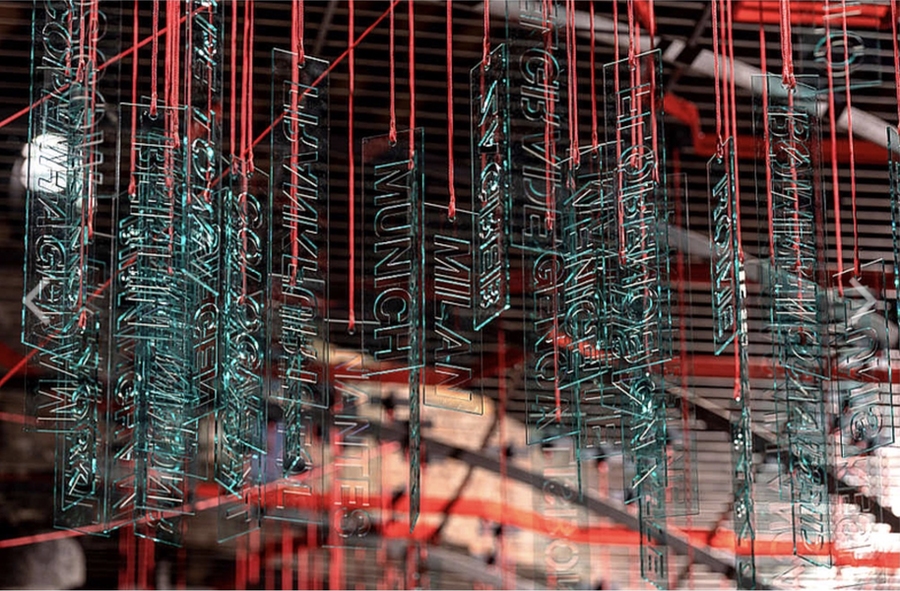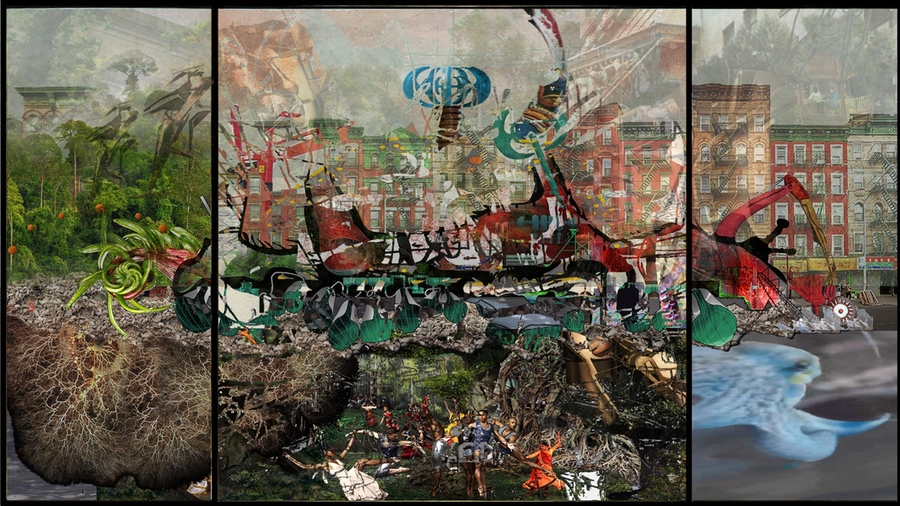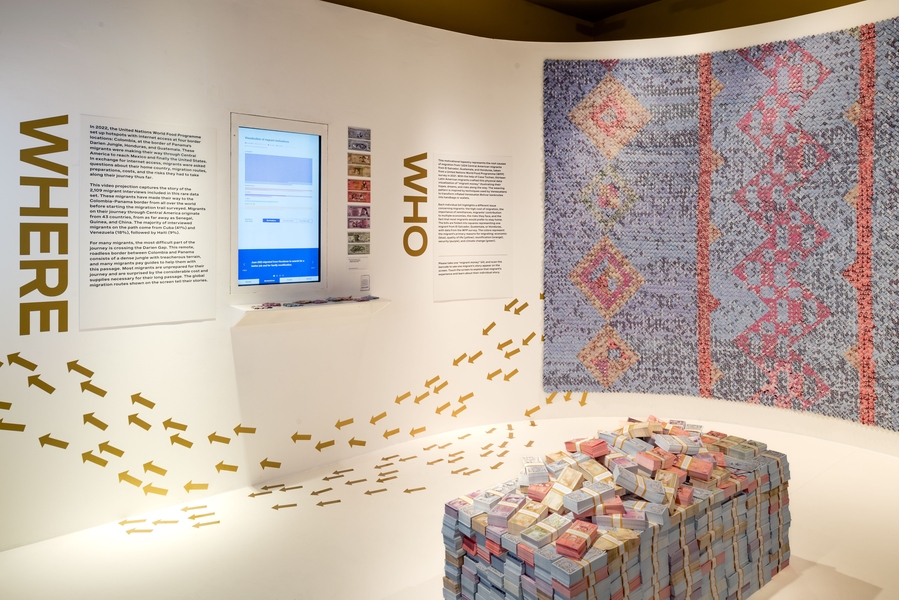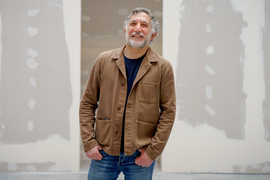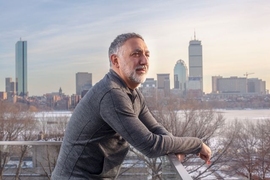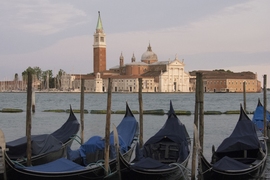The Venice Architecture Biennale, the world’s largest and most visited exhibition focusing on architecture, is once again featuring work by many MIT faculty, students, and alumni. On view through Nov. 26, the 2023 biennale, curated by Ghanaian-Scottish architect, academic, and novelist Lesley Lokko, is showcasing projects responding to the theme of “The Laboratory of Change.”
“This edition of the biennale is truly remarkable. It is profound and accessible at the same time,” says Hashim Sarkis, dean of the MIT School of Architecture and Planning and curator of the previous Venice Biennale. “Our students, faculty, and alumni have responded to the speculative theme with innovative projects at a range of scales and in varied media.”
Below are descriptions of MIT-related projects and activities.
MIT faculty participants
Xavi Laida Aguirre, assistant professor of architecture
Project: Everlasting Plastics
Project description: SPACES, a nonprofit alternative art organization based in Cleveland, Ohio, and the U.S. Department of State’s Bureau of Educational and Cultural Affairs are behind the U.S. Pavilion’s exhibition at this year’s biennale. The theme, Everlasting Plastics, provides a platform for artists and designers to engage audiences in reframing the overabundance of plastic detritus in our waterways, landfills, and streets as a rich resource. Aguirre’s installation covers two rooms and holds a series of partial scenographies examining indoor proofing materials such as coatings, rubbers, gaskets, bent aluminum, silicone, foam, cement board, and beveled edges.
Yolande Daniels, associate professor of architecture
Project: The BLACK City Astrolabe: A Constellation of African Diasporic Women
Project description: From the multiple displacements of race and gender, enter “The BLACK City Astrolabe,” a space-time field comprised of a 3D map and a 24-hour cycle of narratives that reorder the forces of subjugation, devaluation, and displacement through the spaces and events of African diasporic women. The diaspora map traces the flows of descendants of Africa (whether voluntary or forced) atop the visible tension between the mathematical regularity of meridians of longitude and the biases of international date lines.
In this moment we are running out of time. The meridians and timeline decades are indexed to an infinite conical projection metered in decades. It structures both the diaspora map and timeline and serves as a threshold to project future structures and events. “The BLACK City Astrolabe” is a vehicle to proactively contemplate things that have happened, that are happening, and that will happen. Yesterday, a “Black” woman went to the future, and here she is.
Mark Jarzombek, professor of architecture
Project: Kishkindha NY
Project description: “Kishkindha NY (Office of (Un)Certainty Research: Mark Jarzombek and Vikramaditya Parakash)” is inspired by an imagined forest-city as described in the ancient Indian text the Ramayana. It comes into being not through the limitations of human agency, but through a multi-species creature that destroys and rebuilds. It is exhibited as a video (Space, Time, Existence) and as a special dance performance.
Ana Miljački, professor of architecture
Team: Ana Miljački, professor of architecture and director of Critical Broadcasting Lab, MIT; Ous Abou Ras, MArch candidate; Julian Geltman, MArch; Recording and Design, faculty of Dramatic Arts, Belgrade; Calvin Zhong, MArch candidate. Sound design and production: Pavle Dinulović, assistant professor, Department of Sound Recording and Design, University of Arts in Belgrade.
Collaborators: Melika Konjičanin, researcher, faculty of architecture, Sarajevo; Ana Martina Bakić, assistant professor, head of department of drawing and visual design, faculty of architecture, Zagreb; Jelica Jovanović, Grupa Arhitekata, Belgrade; Andrew Lawler, Belgrade; Sandro Đukić, CCN Images, Zagreb; Other Tomorrows, Boston.
Project: The Pilgrimage/Pionirsko hodočašće
Project description: The artifacts that constitute Yugoslavia’s socialist architectural heritage, and especially those instrumental in the ideological wiring of several postwar generations for anti-fascism and inclusive living, have been subject to many forms of local and global political investment in forgetting their meaning, as well as to vandalism. The “Pilgrimage” synthesizes “memories” from Yugoslavian childhood visits to myriad postwar anti-fascist memorial monuments and offers them in a shifting and spatial multi-channel video presentation accompanied by a nonlinear documentary soundscape, presenting thus anti-fascism and unity as political and activist positions available (and necessary) today, for the sake of the future. Supported by: MIT Center for Art, Science, and Technology (CAST) Mellon Faculty Grant.
Adèle Naudé Santos, professor of architecture, planning, and urban design; and Mohamad Nahleh, lecturer in architecture and urbanism; in collaboration with the Beirut Urban Lab at the American University of Beirut
MIT research team: Ghida El Bsat, Joude Mabsout, Sarin Gacia Vosgerichian, Lasse Rau
Project: Housing as Infrastructure
Project description: On Aug. 4, 2020, an estimated 2,750 tons of ammonium nitrate stored at the Port of Beirut exploded, resulting in the deaths of more than 200 people and the devastation of port-adjacent neighborhoods. With over 200,000 housing units in disrepair, exploitative real estate ventures, and the lack of equitable housing policies, we viewed the port blast as a potential escalation of the mechanisms that have produced the ongoing affordable housing crisis across the city.
The Dar Group requested proposals to rethink the affected part of the city, through MIT’s Norman B. Leventhal Center for Advanced Urbanism. To best ground our design proposal, we invited the Beirut Urban Lab at the American University of Beirut to join us. We chose to work on the heavily impacted low-rise and high-density neighborhood of Mar Mikhael. Our resultant urban strategy anchors housing within a corridor of shared open spaces. Housing is inscribed within this network and sustained through an adaptive system defined by energy-efficiency and climate responsiveness. Cross-ventilation sweeps through the project on all sides, with solar panel lined roofs integrated to always provide adequate levels of electricity for habitation. These strategies are coupled with an array of modular units designed to echo the neighborhood’s intimate quality — all accessible through shared ramps and staircases. Within this context, housing itself becomes the infrastructure, guiding circulation, managing slopes, integrating green spaces, and providing solar energy across the community.
Rafi Segal, associate professor of architecture and urbanism, director of the Future Urban Collectives Lab, director of the SMArchS program; and Susannah Drake.
Contributors: Olivia Serra, William Minghao Du
Project: From Redlining to Blue Zoning: Equity and Environmental Risk, Miami 2100 (2021)
Project description: As part of Susannah Drake and Rafi Segal’s ongoing work on “Coastal Urbanism,” this project examines the legacy of racial segregation in South Florida and the existential threat that climate change poses to communities in Miami. Through models of coops and community-owned urban blocks, this project seeks to empower formerly disenfranchised communities with new methods of equity capture, allowing residents whose parents and grandparents suffered from racial discrimination to build wealth and benefit from increased real estate value and development.
Nomeda Urbonas, Art, Culture, and Technology research affiliate; and Gediminas Urbonas, ACT associate professor
Project: The Swamp Observatory
Project description: “The Swamp Observatory” augmented reality app is a result of two-year collaboration with a school in Gotland Island in the Baltic Sea, arguably the most polluted sea in the world. Developed as a conceptual playground and a digital tool to augment reality with imaginaries for new climate commons, the app offers new perspective to the planning process, suggesting eco-monsters as emergent ecology for the planned stormwater ponds in the new sustainable city.
Sarah Williams, associate professor, technology and urban planning
Team members: listed here.
Project: DISTANCE UNKNOWN: RISKS AND OPPORTUNITIES OF MIGRATION IN THE AMERICAS
Project description: On view are visualizations made by the MIT Civic Data Design Lab and the United Nations World Food Program that helped to shape U.S. migration policy. The exhibition is built from a unique dataset collected from 4,998 households surveyed in El Salvador, Guatemala, and Honduras. A tapestry woven out of money and constructed by the hands of Central America migrants illustrates that migrants spent $2.2 billion to migrate from Central America in 2021.
MIT student curators
Carmelo Ignaccolo, PhD candidate, Department of Urban Studies and Planning (DUSP)
Curator: Carmelo Ignaccolo; advisor: Sarah Williams; researchers: Emily Levenson (DUSP), Melody Phu (MIT), Leo Saenger (Harvard University), Yuke Zheng (Harvard); digital animation designer: Ting Zhang
Exhibition Design Assistant: Dila Ozberkman (architecture and DUSP)
Project: The Consumed City
Project description: “The Consumed City” narrates a spatial investigation of “overtourism” in the historic city of Venice by harnessing granular data on lodging, dining, and shopping. The exhibition presents two large maps and digital animations to showcase the complexity of urban tourism and to reveal the spatial interplay between urban tourism and urban features, such as landmarks, bridges, and street patterns. By leveraging by-product geospatial datasets and advancing visualization techniques, “The Consumed City” acts as a prototype to call for novel policymaking tools in cities “consumed” by “overtourism.”
Bahraini National Pavilion
Latifa Alkhayat (MArch ’23 and current SA+P teaching fellow) and Maryam Aljomairi SMArchS ’22 (Design + Computation) co-curated and designed the pavilion.
Research team: Zhicheng Xu MArch ’22, Landcaping; Vijay Rajkumar MArch ’23, Pavilion's Music and Sound Design; Natalie Pearl MAch ’23, Hydrophobic Coating Design + Research; Nada AlMulla MArch ’23, Lead Publication Illustrator; Sasha McKinlay MArch ’23, Cover Illustration; Khushi Nansi SMArchS ’23, Book Editor; Angela Loescher-Montal MArch ’23, English Copyediting; Chenyue xdd Dai (current MArch student), Web development.
Project: (Sweating Assets)
Project description: Sweating Assets entails the use of existing systems to their best capacities rather than starting anew. Our built environments, infrastructure, and relationships are a complex, resource-rich landscape with often overlooked offerings. In particular, the exhibition sheds light on water condensation from the interaction of cooling systems with Bahrain’s hot and humid climate. By no means encouraging wasteful usage of air conditioners, the research uncovers the possibilities (rather than solutions) made through their inevitable consumption. In Bahrain’s intense conditions air conditioning produces proportionally high condensate. Utilizing this unintended by-product of anthropogenic activity ties loose ends, redirecting water to parts of a larger ecology.
MIT-affiliated auxiliary events
Rania Ghosn, associate professor of architecture and urbanism, El Hadi Jazairy, Anhong Li, and Emma Jurczynski, with initial contributions from Marco Nieto and Zhifei Xu. Graphic design: Office of Luke Bulman.
Project: Climate Inheritance
Project description: “Climate Inheritance” is a speculative design research publication that reckons with the complexity of “heritage” and “world” in the Anthropocene Epoch. The impacts of climate change on heritage sites — from Venice flooding to extinction in the Galapagos Islands — have garnered empathetic attention in a media landscape that has otherwise mostly failed to communicate the urgency of the climate crisis. In a strategic subversion of the media aura of heritage, the project casts World Heritage sites as narrative figures to visualize pervasive climate risks all while situating the present emergency within the wreckage of other ends of worlds, replete with the salvages of extractivism, racism, and settler colonialism.
Rebuilding Beirut: Using Data to Co-Design a New Future
SA+P faculty, researchers, and students are participating in the sixth biennial architecture exhibition “Time Space Existence,” presented by the European Cultural Center. The exhibit showcases three collaborative research and design proposals that support the rebuilding efforts in Beirut following the catastrophic explosion at the Port of Beirut in August 2020.
“Living Heritage Atlas” captures the significance and vulnerability of Beirut’s cultural heritage.
“City Scanner” tracks the environmental impacts of the explosion and the subsequent rebuilding efforts. “Community Streets” supports the redesign of streets and public space.
The work is supported by the Dar Group Urban Seed Grant Fund at MIT’s Norman B. Leventhal Center for Advanced Urbanism.
Team members:
Living Heritage Atlas
Civic Data Design Lab and Future Heritage Lab at MIT
Associate Professor Sarah Williams, co-principal investigator (PI)
Associate Professor Azra Aksamija, co-PI
City Scanner
Senseable City Lab at MIT with the American University of Beirut and FAE Technology
Professor Carlo Ratti, co-PI
Fábio Duarte, co-PI
Simone Mora, research and project lead
Community Streets
City Form Lab at MIT with the American University of Beirut
Associate Professor Andres Sevtsuk, co-PI
Professor Maya Abou-Zeid, co-PI
School of Architecture and Planning alumni participants
Rodrigo Escandón Cesarman SMArchS Design ’20 (co-curator, Mexican Pavilion)
Felecia Davis PhD ’17 Design and Computation, SOFTLAB@PSU (Penn State University)
Jaekyung Jung SM ’10, (with the team for the Korean pavilion)
Vijay Rajkumar MArch ’22 (with the team for the Bahrain Pavilion)
Other MIT alumni participants
Basis with GKZ
Team: Emily Mackevicius PhD ’18, brain and cognitive sciences, with Zenna Tavares, Kibwe Tavares, Gaika Tavares, and Eli Bingham
Project description: The nonprofit research group works on rethinking AI as a “reasoning machine.” Their two goals are to develop advanced technological models and to make society able to tackle “intractable problems.” Their approach to technology is founded less on pattern elaboration than on the Bayes’ hypothesis, the ability of machines to work on abductive reasoning, which is the same used by the human mind. Two city-making projects model cities after interaction between experts and stakeholders, and representation is at the heart of the dialogue.

